There are three main contenders in the three-quarter-ton (2500) class but only one of them is in the four figure class . . . when it comes to torque.
The Ford F250’s 6.7 liter turbodiesel V8 makes more than 1,000 ft.-bs. of it. Which explains why it can pull more than 20,000 lbs. – another figure that puts this Ford in a class by itself.
The F250 is Ford’s heavy-duty full-size pick-up.
Like its main rivals – the Chevy Silverado 2500 and Ram 2500 – it comes standard with a big (gas) V8 and offers an even bigger gas V8 – as well as regular, extended and crew cab bodystyles with an eight foot long bed available with any of those cab styles – something not available in many light-duty/half-ton trucks, which don’t come standard with a big V8, either.
But the big Ford offers – by far – the brawniest diesel as well as the highest maximum tow rating of the bunch.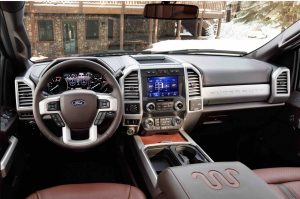
It also has something else – an all-aluminum (rather than steel) body – which has its good and its bad points.
Prices start at $34,035 for an XL trim regular cab with a 6.2 liter V8. A top-of-the-line Limited crew cab with the 6.7 liter Powerstroke diesel – a $10k option -plus 4WD and all the bells and whistles can sticker for more than $80,000.
What’s New
The optional 6.7 liter turbodiesel V8 is uprated from 953 ft.-lbs. of torque last year to 1,050 ft.-lbs. this year.
A new 7.3 liter gas V8 is also available.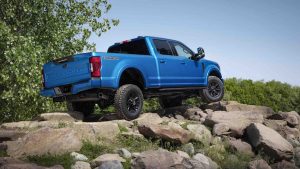
It’s the biggest gas V8 in the class – and it’s also a pushrod V8.
Not an overhead cam V8.
A Tremor off-road package has been added to the menu as well. It’s a step up from the FX4 off-road package available last year (and available with the half-ton F-150).
Literally a step up.
F250s so equipped get a 2-inch lift kit that raises the body up that much vs. the standard truck, 35-inch Goodyear M/S-rated knobby tires, a limited-slip front differential, locking rear diff, rock-crawl mode for the transmission and a low-speed cruise control system unique to this version of the truck.
It has 10.3 inches of minimum clearance and can ford 33 inches of water.
The hunkiest of the bunch.
Three engines to choose from vs. the usual two: OHC gas V8. OHV V8 or turbodiesel V8.
Regular cab/eight-foot bed availability (increasingly not available in the half-ton class).
What’s Not So Good
Diesel option costs almost as much as some cars do.
Aluminum body costs more to fix than steel.
Getting into the bed takes a step ladder.
Under The Hood
Unlike half ton trucks – which all come standard with little sixes – the F250 (and its three-quarter-ton rivals) all come standard with huge V8s.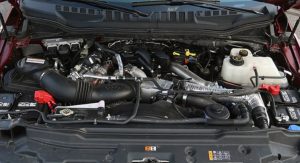
The F250’s smallest (standard) V8 displaces 6.2 liters and belts out 385 horsepower and 430 ft. lbs. of torque – enough to pull 15,800 lbs. – about 2,000 bs. more than than any half ton truck can handle with its largest available engine.
For more – of everything – the F250 offers a massive 7.3 liter V8. It is the biggest V8 you can get in . . . anything. It is also a pushrod/overhead valve V8 – Ford’s first in a long time. This will address concerns some have about the long-term durability of OHC engines in trucks and is without question a simpler engine, with fewer parts.
It makes 430 horsepower, 475 ft.-lbs. of torque and ups the F250’s towing capabilities to 19,500 lbs.
Which is more than the Chevy Silverado 2500 can pull with its top-dog 6.6 liter Duramax turbodiesel and essentially as much as the Ram 2500 with its optional 6.7 liter turbodiesel can handle (19,680 lbs.)
And there’s more to come – if you choose the Ford’s third available engine.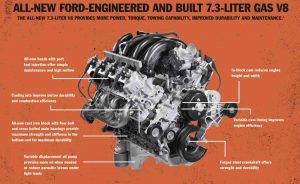
It’s the 6.7 liter Powerstroke turbodiesel V8, the only four-figure V8 you can get (shy of a Peterbilt) and the only one in the class rated to pull a foundation-ripping 22,800 lbs.
The standard 6.2 V8 is paired with a six-speed automatic but both the 7.3 gas V8 and the 6.7 liter Powerstroke diesel come standard with heavy-duty ten-speed automatics that have a very deep .63 overdrive in tenth. All three engines can be paired with rear-drive (2WD) or 4WD and with any cab/bed or trim configuration.
Ford doesn’t upsell you a cab or trim before it will sell you a bigger V8.
Or the diesel V8.
PS: Neither of the F250’s gas V8s are direct-injected.
Really capable trucks with solid axles and leaf springs like this one used to be a handful. They were great on the job site, just the ticket for getting your Airstream to the camp site. But they were like Mr. Universe-level bodybuilders in that they were just too big- and much too clunky – for everyday driving. They rode like your grampa’s farm tractor and were just as loud, almost.
Amenities? If you had carpet you were riding in style.
Now there’s only a pea under 30 or so mattresses’ worth of difference in ride quality, noise and even handling between a half-ton luxo-truck like the 2020 Ram 1500 I wrote about last week (see here) and this truck.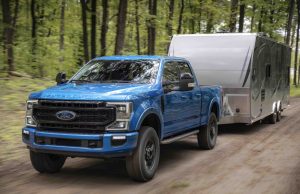
Well, once you’re inside.
As upsized as the current crop of half-ton trucks are, the 2500s are even more so – especially vertically. Running boards are not optional – unless you’re an NBA forward. You climb up, pull yourself in.
But once you’re settled in, the rest is easy.
It’s almost as if – no, it’s exactly as if – anyone could drive this truck. Like a friend of mine, who is female and about half my size. Power the seat forward, adjust the power tilt and telescoping wheel. Push the start button and put the drive-by-wire automatic into the gear. Off she goes!
It does not take a caveman – or even a man – to do it.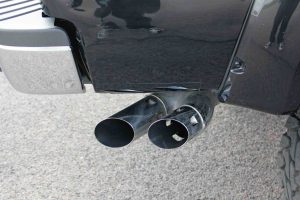
Another thing you’ll notice about this Ford is that while it’s tall it’s not too wide. It’s only about five inches wider (80 inches) than, for instance, a current Camaro (74.7 inches). That means it’s not a constant chore to keep this truck in its lane rather than the opposing lane. There’s Lane Keep Assist, of course – but it’s an assist you won’t need and can (thank god) turn off.
If you buy the diesel, you can turn on the exhaust brake to keep the big lug from picking up too much speed in its lane while going downhill. You’ll feel like a Peterbilt driver – just without the Peterbilt.
Also, you can go far – despite the big-rig appetite of the big V8s.
Regular cab F250s come standard with a 29 gallon fuel tank but you can get a 34 gallon tank with extended cab models and a 48 gallon tank with crew cab versions.
That’s a lot of gazzuline – or diesel.
Enough to travel four digits – even at 25 MPG.
Ford’s Super Duty series of trucks used to look very different from the light-duty F-150. But then styling overlap happened and the Super Duty look – high bed walls, inverted hockey stick driver and passenger-side door uppers – became the look of the half tons.
What separates the Super Duty from the half-tons of today – aside from the heavier-duty underthings and the much bigger things under the hood – is the limitless configurations of cab and bed. The eight-foot bed goes with any cab – not just the regular cab.
And you can still get a regular cab, too.
Carpet isn’t the only standard amenity, either. The base XL has AC, telescoping tow mirrors and a stereo with four speakers. It comes with manual windows, the one throwback to what a three-quarter-ton truck was like.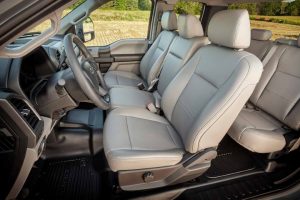
Some people will like that.
Manual roll-up windows have definite advantages, including being able to roll them up – or down – exactly as far as you want them to go. With power windows, it can be almost impossible to get the window to stop going up – or down – exactly where you wanted. And manual windows are simpler. They rarely fail and if they do, it’s a mechanical issue – not an electrical one.
And not a body control module issue, either.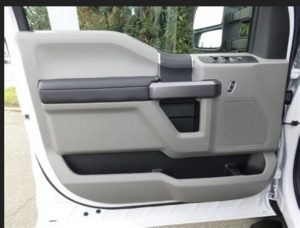
Many people get a rude surprise when they learn that – with modern vehicles – its not just an electric motor or electric connections that you have to deal with also but another computer that controls what goes up and down.
And that can be not cheap.
Power windows come standard in XLT and up trims, along with Ford’s Sync 3 infotainment system piped through an eight-inch LCD touchscreen.
If you want two-tone leather seats (with three-stage heating and cooling), a power tailgate and a very powerful Bang & Olufsen premium audio rig to go with your rig, they’re available in the Platinum and Limited trims. These also come with power-deploying running boards; the Limited adds a panorama sunroof – just like a Lincoln (that can haul several Lincolns).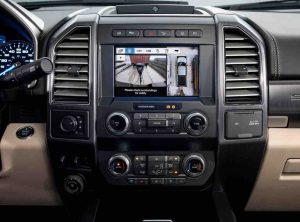
And even that isn’t the end of it. You can get a King Ranch version with power-adjustable pedals and a heated steering wheel.
There’s very little that’s not available in the F250 that you could get in the F-150. But you can’t get the F-150 with any of the monster-truck V8s that come in the F250. Or the car-crushing Tremor package.
This is interesting because there’s more than a little price overlap between the half-ton F-truck and the three-quarter-ton F-truck. Especially if you make it at least kind-sorta comparable in terms of capability.
The base F250 XL trim has a standard V8 – and can pull almost 16,000 lbs. as it comes. You can buy it for $34k plus pizza money. An F-150 with its strongest available engine – which isn’t a V8 – and doesn’t tow close to as much – will cost you about the same.
Ford has made the F250 so appealing it may pull sales away from the F-150!
At least it’s all in the family.
The Rest
This truck’s big weakness – literally – is its aluminum body. Not so much in terms of strength but rather cost.
Ford describes this as “military grade” and it surely is. The military uses aluminum (in airplanes and such) to reduce weight more than impart strength. Ford used it in the F250 (and F-150) for the same reason.
The question is whether shaving (roughly) 400 pounds of weight by using aluminum rather than steel is worth the cost to truck buyers.
Pick-ups don’t have to fly, after all.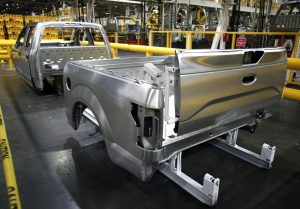
The main reason for the aluminum panels isn’t even to reduce weight – per se. It is to reduce the pressure coming from Uncle to increase fuel economy and (lately) to decrease carbon dioxide “emissions” (rebranded as such because the actually harmful ones are no longer plausibly an issue justifying further regulation).
Are either of these things of importance to the people who buy trucks?
The F250’s mileage isn’t dramatically better than its rivals.
Uncle doesn’t even require manufacturers of vehicles in this class to publish them. Because everyone – even Uncle – knows that people who buy 2500s (and up) care about gas mileage about as much as Trump cares about not offending snowflakes.
All else being equal, the Ford’s mileage is probably 2-3 MPG better overall than it would have been if it were steel bodied and lugging around another 400 or so pounds.
Is it a big sell? Probably not.
But people who buy heavy-duty work-intended trucks do care a great deal about durability, the ability to withstand damage and the cost to fix damage. Aluminum is tough in some ways; for example, it can flex more than steel without deforming permanently. And of course, it corrodes differently than steel.
Bu if you bend it too far – or a deer bends it too far – it’s harder to pull back into shape and welding it is a higher art form than steel welding. That adds potentially higher repair costs which will probably also result in higher insurance costs.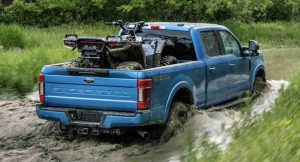
It’s the one debatable aspect of this otherwise King-of-the-Hill truck.
The Bottom Line
If this truck were made of steel, it’d be so far ahead of the pack it could stop by the side of the road for a Big Gulp and a pee break and still beat them to the finish line.
With 22,000-plus pounds riding on the bumper.
. . .
Got a question about cars, Libertarian politics – or anything else? Click on the “ask Eric” link and send ’em in!
If you like what you’ve found here please consider supporting EPautos.
We depend on you to keep the wheels turning!
Our donate button is here.
If you prefer not to use PayPal, our mailing address is:
EPautos
721 Hummingbird Lane SE
Copper Hill, VA 24079
PS: Get an EPautos magnet or sticker or coaster in return for a $20 or more one-time donation or a $10 or more monthly recurring donation. (Please be sure to tell us you want a magnet or sticker or coaster – and also, provide an address, so we know where to mail the thing!)
If you’d like an ear tag – custom made! – just ask and it will be delivered.
My latest eBook is also available for your favorite price – free! Click here. If that fails, email me at [email protected] and I will send you a copy directly!




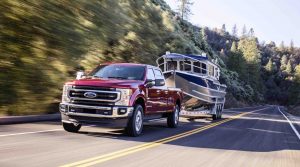

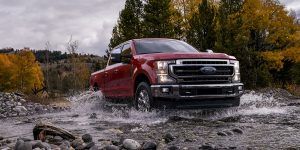
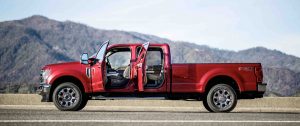








[…] to buy (for example, the Powerstroke diesel offered as optional equipment with the Ford F250 I recently test drove costs more than $10,000) and to fuel. Diesel — via “low sulfur” regulations — […]
These large trucks are getting bigger and uglier by the day. I saw one the other night in my rear view. All I saw was a huge grill and LED lights
I have a ’16 with the 6.2. At 80k, The valve spring in the #7 snapped on the highway, and in the short time it took me to get off the road, the resulting fuel dump into the exhaust killed the cat. $4k later I was back on the road. Love the truck, and lovED the engine, but I’ll be trading for the pushrod 7.3 when the time comes. In other news, my old ’99 5.4 2 valve ‘going to the dump’ truck just keeps going and going and going with nothing but fluid changes. Thanks for the review, Eric!
Jeff, that is why I always say that if ya want a good ol’ reliable truck, whether gas or diesel, ya gotta go pre-’04. After that, they came out with the notoriously bad 6.0 diesel, and then the “replacement” to rectify that boner- the 6.4, which proved to be just as bad or worse…and pretty much everything following, even if somewhat improved, requires removal of the FREAKING cab for many repairs (Don’t know if it’s different with these 2020’s or not… Eric?) and the gas jobs went to three-valve and VVT after ’04 (or in some cases ’05) and are notorious for dropping valves and other major malfunctions…… The problems are so common, that they happen to virtually everyone who keeps one of these trucks long-term. Get one used, and you’re looking at frequent $3-$5K repair bills every time something goes wrong….and forget DIY, ’cause lifting cabs off the chassis ain’t much fun, ‘specially when ya don’t have the equipment for it.
It’s a damn shame…disposable trucks. And considering what they cost…it’s really a disgrace. But hey, after enough conned-sumers catch-on, I’m sure Uncle can bail Ford out…so why should they care?
(And not to say that the other brands aren’t as bad or worse…it’s just that Ford used to be the good one)
This is why ya see pre-’03 F250’s and 350’s selling for absurdly high prices….gas and diesel- ’cause they’re the only ones left that really hold up. Brickman, a national landscaping company actually switched to gas trucks due to the 6.0 diesel fiasco! (One of my clients actually had a bunch of their old 6.0’s he got at auction to sell off….then went way cheaper than what an older comparable 7.3 would bring)
Oh I lived the 6.0 nightmare! I had one in the truck I traded the ‘I’m never buying a diesel again’ march to the Ford dealer to get my 6.2 gasser!
The high pressure oil pump, and the turbo went at inopportune times. Before TSHTF with that engine at around 60k, it had been my “favorite truck ever.” Thought about spending the bucks to have it “bulletproofed,” but cut my losses. When those 6.0s are working, they’re a TON of fun! Somehow I’m still a Ford guy. I haul a lot of weight, and none carry it better.
Yeah, it’s ridiculous, Jeff- It can cost $12K-$15K to have those 6-leakers bulletproofed properly- and they’re still a nightmare if something goes wrong, ’cause of accessibility(Leaks, etc.)…and not to mention all of the electronic BS, which is common to all of the modern diesels. It’s a DISGRACE.
But yes, the towing. Friend of mine used to tow 20K+ halfway across the country on a regular basis. He tried Dodges, ’cause of the Cummins…but the damn trucks fell apart and suspensions were weak- so he started using Fords exclusively- but only the 7.3’s.
Only a Ford’ll do this (Same guy):
https://i.imgur.com/ZXBckIy.jpg
M<y next one's gonna be one of the old IDI diesels….'cause if it ain't got an injector pump…it ain't a diesel in my book (Or I'll just stick with gas)
Ford did this truck right. If it lasts like the other F250 iterations it will be a 15 year+ usable vehicle. 70K over 15 years is 6,600/yr. That’s not bad. I have 2 F250s (One is an ’04 Excursion 4WD which is an SUV body of a F250 frame) the other is a 2010 gasser. After 2 decades of owning Ford trucks I can tell you that the rigs are worth the cost new. Another supporting argument for value is how much a 2,4,6,8,10 year old one costs. If they were junk the used truck prices would reflect it. As it is today used F250 diesels are the most expensive used truck you can buy- for a reason. They are worth it to the check writers.
One thing about pricing: We all want the prices to be at our budget’s definition of “affordable” or at least justifiable. If the FED and GovCo would get out of our way and let us earn, create, produce, save, invest a lot more guys could write that fat check and not wince doing it.
I hate all of the newer trucks- They try so hard to make them, look tough- but they are fragile. Ya wouldn’t dare use these delicate aluminum-bodied $70K luxury suburban haulers for any actual work. Maybe if they’d actually make them tough, they wouldn’t have to make them so pretentious-looking. (And I love my OLD F250 with extended cab and REAL 8′ bed!)
Hi Nunz!
They do what they can. Keep in mind that Ford did the alloy body because of Uncle. But it did a great job otherwise. I don’t think there’s a previous 2500 capable of pulling as much as the new F250 can. And 1,000-plus ft.-lbs. of torque? As Swamp noted, even the base trim has a nice big V8, can pull almost 16,000 lbs. and is available in the regular cab/extended cab/eight-foot configuration most useful for work.
It’s not even that expensive in this configuration; about $35k or so – which isn’t unreasonable given the capability and also probably the durability. This truck ought to last for 25-30 years.
Mornin’ Eric!
Heh, yeah, I was very glad to hear that they at least still offer the 8′ bed on these! IMO, for pick-ups…pick-ups that are actually gonna be used as pick-ups, Fords are the only real options these days. I’d feel a lot better about them though if it weren’t for the aluminium [Wink to the Aussies] bodies- and I don’t believe that it’s ’cause Uncle, ’cause as I said, that 400 lbs. doesn’t mean squat. If you still have the truck, toss 400 lbs of something into the bed and drive it around a bit….see if it even alters the MPGs by 1 MPG. If 400 lbs. could do that, that would mean that these trucks would get negative number MPGs when towing thousands of pounds…..
25-30 years? I wish! But with the aluminum bodies, you’d have to carry comp and collision for as long as ya owned it (Assuming it doesn’t rust away, like the old aluminum-bodied Chevys!)…and considering Ford’s track record lately with the durability of things mechanical…..I dunno- Their track record hasn’t been so good for the last few decades (Not that the other manufucturers are any different).
3-valve V-8 gassers…6.0 and 6.4 diesels….all disposable. As far as used trucks go, Fords from ’04-’09 are no go’s [in more ways than one!]- This is why the pre-’03’s are retaining so much value.
But I’ll bet this 2020 is sweet to drive around in!
I agree to a point Nunz. I still own two older trucks, a ’99 K2500 regular cab 8ft. and an ’02 K1500HD Crew 6ft. Both are great trucks in their own right, however they really suck at living with them. What I mean is doing 80mph, or going around corners, or driving in 4wd without you binding the drivetrain, or taking the wife out to dinner, or trusting it will take my son and I to a dirtbike race, etc….
I also own two late models, a F150 and Ram1500, and they do the above ‘issues’ very well. Almost as good as my once loved 70’s boat sedans.
Now I won’t be throwing a cord of wood in the newer trucks. I could, but I have the ’99 for that, beat it up. It costs lots of money to keep the old beater going too. $1-3K a year as it rots mechanically from within, and the firewood kids that drive it have no idea how to take care of it (they learn the hard way when they get left on the side of the road, haha).
But your right that $70K is ridiculous, but you can get a really good, capable beyond their means, late model truck for $30-50K, certified one year olds or new. Will these last past 10-15 years without big money, probably not. Unfortunately I am a believer in ya have to pay to drive/work whether you like it or not.
I must be a crude dude, Chris. I think my ’99 F250 is the most luxurious truck I’ve ever owned. It rides nice; it’s comfortable; it handles nice….. But then again, I’ve driven nothing but trucks pretty much my whole life, so I may be prejudiced, not having cars to compare them to. (My ’00 Excursion is my “fancy” vehicle… 🙂 But that’s just an F250 with a “station wagon” back half)
haha! I’m not laughing at you, but with you. I also have driven mostly trucks from the 90’s on up, owning late 80’s on up. 15 of them?
But I also had my fair share of larger sedans, and prior to my ’20 Ram 1500, no truck could ever come close to the ride, comfort, and enjoyment of driving a large sedan over a truck when you do 3+ hours a day.
No way you could get me to daily drive a ’99 anything compared to what’s avail. today. But it’s also relative to living in the NE where potholes can jar your teeth (the whole trip). As always, just my opinion.
**”But it’s also relative to living in the NE where potholes can jar your teeth “**
Ding! Ding! Ding! THAT is the truth! I remember when I first got my 99 F250- My first time driving a “modern” pick-up. I remarked to a friend of mine who was still living in NY at the time, that I was amazed at how nicely the truck rode. He said “That’s only because you live in KY. now, where the roads are nice. Try driving it back here in NY!”.
Hey, I’m sure even back in NY, it’d still be a world better than my old lifted ’81 F250 that used to ride like a tractor! I’m not one to complain about the way a truck rides- I think trucks should ride like trucks…but that ’81 was ridiculous! (It made me lust for Chevys!)
I can’t see how 400 pounds would make 2-3 mpg difference in pickups with these big engines. If that were the case then pulling a 16K# trailer would yield less than 1 mpg.
My old 2 ton V-6 would get 10-11 mpg loaded or empty. (25K vs 10K)
Ican put 400 lbs. in my old GAS F250, and it has absolutely no impact on MPGs. It’s more about gearing and RPMs and the efficiency of the injun. These aluminum bodies are literally good for NOTHING. 400 lbs would make a little difference in a 2500 lb, 4cyl. economy car….
Hi Nunz,
As you know, it’s about the fleet averages. If they can achieve say a 1 MPG increase over the entire production run of a given model over an entire year then it does make sense, from a CAFE compliance perspective. And that’s why they did it.
They could put a narrower tire and wheel on them and the mileage would improve more than 1 mpg. So why not ????
Hi Anon,
Because dem reehums, mang. Another idiot trend is mounting 19, 20-plus inch tall (and commensurately wide) wheels and tires on everything. It began as ghetto thing and now it’s a mainstream idiocy, like the barbed wire tattoo on a guy’s biceps.
Well, I swapped from factory 215/50R17 aluminum wheels/tires to junkyard steel 205/65R15 on our little car and it seems the mileage went up about 2-3 mpg. Anyway, it runs about 26-28 mpg* locally, but on long trips it went up from about 29 to 31. Never did the math on the trip but it has to be getting significantly more than 31 to bring the average up on the car computer.
* still mostly highway, because we don’t live near anything, and we don’t drive it unless we are at least going to town
Anon, do you compensate for the inaccuracy the non-stock sized tires creates on the odometer/MPG thingy?
Just like Fraudski and the Bat Flu, I don’t believe ANY of the official BS anymore. “They” don’t care any more about gas mileage than they do about grandma in the nursing home.
I am NOT a truck guy, but like the 1990 Chevrolet SS454 of three decades ago, this one has some appeal. I liked the SS454 because it had the big torquey V8 and this one does too. $34k is a lot of loot, but I’d rather put it on a base model of this truck versus an F150 or a Silverado. I bet Ford sells a bunch of these. As of now, they are exempt from the upgraded EPA gas mileage standards. That’s why you can get a 7.3 L
If telescoping tow mirrors and power-adjustable pedals are possible, why not a telescoping 5-ft bed that can extend to 8 ft when needed, but save 3 ft of overall length when it’s not?
The death of the 8 foot bed: I’ll never understand that.
These silly 5 foot beds are simply a bad joke.
It’s because almost everyone wants the crew cabs now. 8ft bed on a crew cab is a massive truck. Most of my friends who drive trucks, all crew cabs BTW, all like the 5ft beds.
You can get great deals on extended cab trucks with the 6-4 bed because they aren’t very popular. Again, everyone wants the crew cab.
I’m a holdout though and just bought a Ram crew cab 1500 with the 6’4″ bed. Good compromise for me. Hard to find though unless you order it. If they offered the 8ft bed I wouldn’t have bought it. I do like the massive rear seat area in the new crew cabs as I routinely have to pick up 4 people at the airport.
IMO these crew cabs have become the long gone large sedan that most people used to drive way back.